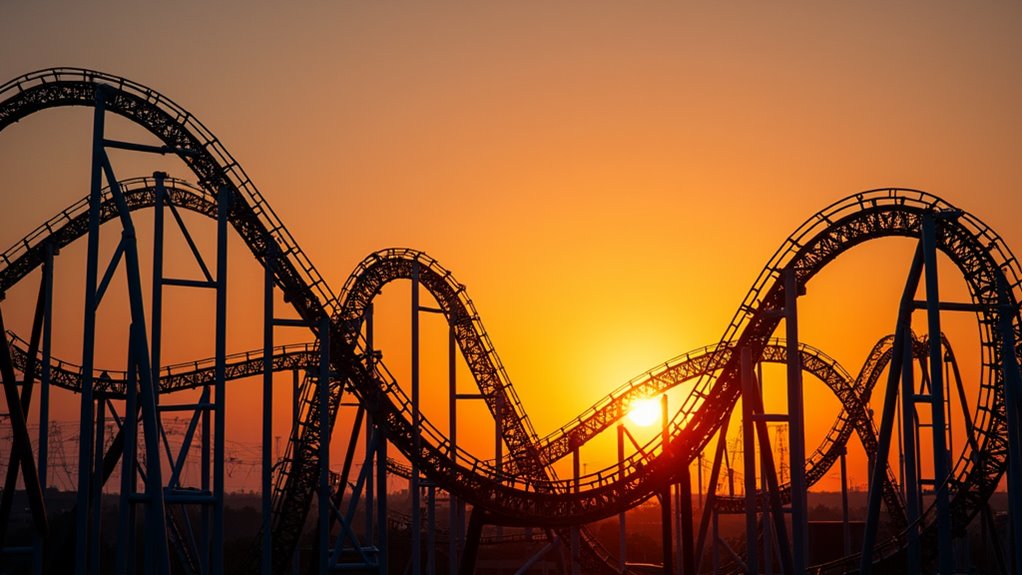You can survive market volatility by focusing on proven strategies rather than emotional reactions. Start by building a diversified portfolio across multiple asset classes, maintaining adequate cash reserves, and setting clear investment goals. Don't let fear drive your decisions during downturns – history shows markets typically recover within a few years. Instead, use market swings as opportunities to rebalance your portfolio and stay aligned with your long-term strategy. Keep your investment frequency in check to avoid anxiety, and remember that patient investors often see the best returns. Understanding these fundamentals will help transform market turbulence from frightening to manageable.
Key Takeaways
- Maintain emotional control during market swings by sticking to a well-planned investment strategy rather than reacting to short-term fluctuations.
- Diversify investments across multiple asset classes, sectors, and regions to reduce overall portfolio risk during market turbulence.
- Keep adequate cash reserves to avoid forced selling during downturns and capitalize on buying opportunities when prices drop.
- Historical data shows markets typically recover within 2-5 years after downturns, emphasizing the importance of staying invested.
- Regular portfolio rebalancing and position sizing help maintain risk levels aligned with long-term financial goals during market volatility.
Understanding Market Volatility Basics

Three key factors drive market volatility: investor sentiment, economic data, and global events. When investors feel uncertain, they often sell stocks rapidly, causing prices to swing dramatically.
Economic indicators like GDP, employment rates, and inflation numbers can trigger sharp market movements as traders adjust their positions based on this data.
You'll notice that markets react swiftly to international developments such as wars, trade disputes, or natural disasters. These events can create ripple effects across various sectors and asset classes.
To navigate this volatility, you need to understand that price fluctuations are normal and often temporary. Rather than panicking during market swings, focus on your long-term investment strategy and remember that historically, markets tend to recover and grow over time.
Emotional Control During Market Swings
Market volatility can trigger powerful emotional responses that cloud your judgment and lead to costly investment mistakes.
When prices plummet, fear might push you to sell at the worst possible time. During market surges, greed could tempt you to make risky, impulsive purchases.
To maintain emotional control, establish a clear investment strategy before market turbulence hits. Focus on your long-term goals rather than short-term market movements.
Create specific rules for buying and selling, and stick to them regardless of market conditions. It's also helpful to limit how often you check your portfolio – constant monitoring can amplify anxiety and stress.
Remember that market swings are normal and temporary.
Building A Resilient Portfolio

While market conditions may fluctuate wildly, a resilient portfolio can help protect your wealth through various economic cycles.
You'll want to focus on diversification across multiple asset classes, including stocks, bonds, real estate, and commodities. Don't put all your eggs in one basket.
Consider incorporating low-correlation assets that tend to move independently of each other. When one sector struggles, another might thrive.
You should also maintain an emergency fund and adjust your asset allocation based on your risk tolerance and time horizon.
Regular rebalancing keeps your portfolio aligned with your long-term goals.
Don't forget to include inflation hedges and consider international investments to spread geographical risk.
Risk Management Strategies
Successful risk management requires mastering key defensive tactics in today's volatile markets.
You'll need to diversify across asset classes, sectors, and geographic regions to reduce exposure to any single risk factor. Set clear stop-loss orders to protect your capital, and don't let emotions drive your decisions during market turbulence.
It's crucial to size your positions appropriately – never risk more than you can afford to lose on any single investment.
You should also maintain adequate cash reserves to capitalize on opportunities and avoid forced selling during downturns. Consider using hedging strategies like options or inverse ETFs when market conditions warrant protection.
Regular portfolio rebalancing keeps your risk levels in check and ensures you're not overexposed to any particular market segment.
Market Timing Vs Long-Term Investing

Investors often debate whether timing the market or maintaining long-term positions yields better returns. Market timing involves predicting market movements to buy low and sell high, which can produce significant gains if you're right. However, it's incredibly difficult to consistently time markets correctly, and missed opportunities can be costly.
Long-term investing focuses on holding quality investments through market cycles, relying on compound interest and time in the market rather than timing. You'll likely experience volatility, but historical data shows that markets tend to rise over extended periods. This approach requires less active management and typically results in lower transaction costs.
While both strategies can work, long-term investing has proven more reliable for most individual investors. It's less stressful, requires less expertise, and often produces better risk-adjusted returns over time.
Recovery After Market Downturns
After market downturns shake investor confidence, understanding historical recovery patterns can help you stay focused on your financial goals.
Markets have consistently demonstrated resilience following significant declines, with recovery periods varying based on economic conditions and market dynamics.
You'll find that major market indices typically recover within two to five years after severe downturns. For instance, following the 2008 financial crisis, the S&P 500 took about four years to reach its previous peak.
During recovery phases, staying invested becomes crucial, as missing just a few of the market's best days can significantly impact your long-term returns.
While past performance doesn't guarantee future results, history shows that patient investors who maintain their positions through downturns often benefit from the market's eventual rebound.
Frequently Asked Questions
How Do International Political Events Specifically Affect My Local Market Investments?
International political events can directly impact your local investments through multiple channels.
You'll see changes in currency values affecting import-export businesses in your area, shifts in consumer confidence altering spending at local companies, and global supply chain disruptions influencing local manufacturers' costs.
When major conflicts or trade disputes occur, they can shake investor confidence, triggering market volatility that reaches your community-based investments.
Can Social Media Trends Predict Short-Term Market Movements Accurately?
While social media's instant buzz can seem like a crystal ball for market moves, it's often more noise than signal.
You'll find that viral tweets and trending topics might spark short-term price swings, but they rarely predict sustained market movements.
Studies show that social sentiment indicators are most reliable when combined with traditional market analysis, rather than used alone.
Don't let social media FOMO drive your investment decisions.
What Role Do Cryptocurrency Fluctuations Play in Traditional Market Behavior?
Cryptocurrency fluctuations increasingly influence traditional markets through several channels.
You'll notice that crypto volatility can trigger shifts in investor sentiment, affecting risk appetite across asset classes. When major cryptocurrencies crash or surge, they'll impact tech stocks and financial sectors most directly.
You're also seeing institutional investors who hold both crypto and traditional assets adjusting their portfolios simultaneously, creating ripple effects throughout conventional markets.
How Do Generational Investing Differences Impact Overall Market Performance?
Picture a family dinner where grandma clutches her bonds, dad trades blue-chip stocks, and your tech-savvy cousin raves about NFTs.
You'll find that different generations approach investing distinctly: Boomers prefer stability, Gen X seeks balanced portfolios, while Millennials and Gen Z gravitate toward digital assets and ESG investments.
These varying strategies create market waves, impacting volatility and shifting capital flows between traditional and emerging sectors.
Should I Adjust My Investment Strategy Based on Federal Reserve Meeting Dates?
While you shouldn't make drastic changes based on Fed meetings alone, it's smart to stay informed about their decisions.
These meetings can impact market volatility and interest rates, but trying to time the market around them often leads to poor results.
Instead, focus on maintaining your long-term investment strategy.
If you're concerned, you might consider adjusting your asset allocation before major announcements to reduce potential risks.
Conclusion
Remember that market history tells a compelling story: despite experiencing an average of one 14% decline each year, the S&P 500 has delivered positive returns in 32 of the last 42 years. You'll face volatility, but by staying focused on your long-term strategy, managing your emotions, and maintaining a well-diversified portfolio, you're better positioned to ride out the market's inevitable ups and downs.

Leave a Reply